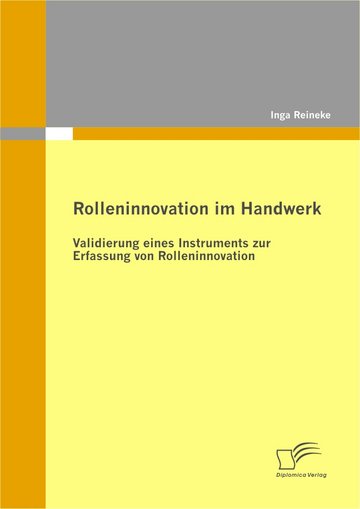| Rolleninnovation im Handwerk | 1 |
| ZUSAMMENFASSUNG | 3 |
| INHALTSVERZEICHNIS | 5 |
| TABELLENVERZEICHNIS | 7 |
| ABBILDUNGSVERZEICHNIS | 8 |
| 1. EINFÜHRUNG | 9 |
| 2. INNOVATION IM HANDWERK – das InnoWerk Projekt | 13 |
| 3. INNOVATION | 15 |
| 3.1 Definition und Konzepte | 16 |
| 3.2 Innovation, Veränderung und Kreativität | 19 |
| 3.2.1 Innovation und Veränderung | 19 |
| 3.2.2 Innovation und Kreativität | 20 |
| 3.3 Unterteilung von Innovation nach Merkmalen | 21 |
| 3.4 Unterteilung von Innovation nach Betrachtungsebene | 24 |
| 3.4.1 Organisatorische Innovation | 24 |
| 3.4.2 Gruppenbezogene Innovation | 27 |
| 3.4.3 Individuelle Innovation | 28 |
| 3.5 Unterteilung von Innovation – Ein Zwischenfazit | 31 |
| 3.6 Messung von Innovation | 33 |
| 4. ROLLENINNOVATION | 36 |
| 4.1 Definition und Konzepte | 37 |
| 4.1.1 Rolleninnovation nach Brim | 37 |
| 4.1.2 Creativ Modeling von Bandura | 37 |
| 4.1.3 Kirtons Kozept der Adaption-Innovation | 38 |
| 4.1.4 Nicholsons Theorie des Arbeitsrollenwandels | 39 |
| 4.1.5 Weiterentwicklung von West | 41 |
| 4.1.6 Rolleninnovation nach Farr und Ford | 41 |
| 4.2 Rolleninnovation, job crafting, personal initiative und organisational citizenship behavior | 43 |
| 4.2.1 Rolleninnovation und job crafting | 43 |
| 4.2.2 Rolleninnovation und personal initiative | 44 |
| 4.2.3 Rolleninnovation und Organizational Citizenship Behavior | 45 |
| 4.3 Modelle der Einflussfaktoren und Zusammenhänge | 46 |
| 4.3.1 Ein konzeptionelles Modell der Rolleninnovation von Farr und Ford | 46 |
| 4.3.2 Aus der Not geborene Innovationen: Ein integratives Modell | 49 |
| 4.4 Messansätze zu Rolleninnovation | 51 |
| 4.5 Weiterentwicklung im Projekt InnoWerk | 56 |
| 5. FRAGESTELLUNG DER EMPRISCHEN UNTERSUCHUNG | 60 |
| 5.1 Nebenfragestellungen | 62 |
| 6 GÜTEKRITERIEN | 63 |
| 6.1 Objektivität | 63 |
| 6.2 Reliabilität | 63 |
| 6.3 Validität | 64 |
| 7. METHODIK DER EMPIRISCHEN UNTERSUCHUNG | 66 |
| 7.1. Verwendete Instrumente zur Erfassung der Rolleninnovation | 66 |
| 7.2 Stichprobe | 67 |
| 7.3 Ablauf | 71 |
| 8. ERGEBNISSE DER EMPIRISCHEN UNTERSUCHUNG | 72 |
| 8.1 Prüfung des Selbsteinschätzungsfragebogens | 73 |
| 8.1.1 Kennwerte und Verteilung | 73 |
| 8.1.2 Struktur der Skala | 76 |
| 8.2 Prüfung des Fremdeinschätzungsfragebogens | 85 |
| 8.2.1 Kennwerte und Verteilung | 85 |
| 8.2.2 Struktur der Skala | 88 |
| 8.3 Prüfung der externen Validität | 91 |
| 8.4 Ergebnisse zur Nebenfragestellung | 96 |
| 9. DISKUSSION DER BEFUNDE | 99 |
| 9.1 Methodische Probleme der Untersuchung | 99 |
| 9.2 Interpretation der Ergebnisse | 101 |
| 9.3 Fazit und Ausblick | 106 |
| 10. LITERATURVERZEICHNIS | 107 |
| 11. ANHANG | 111 |
| Autorenprofil | 116 |
















